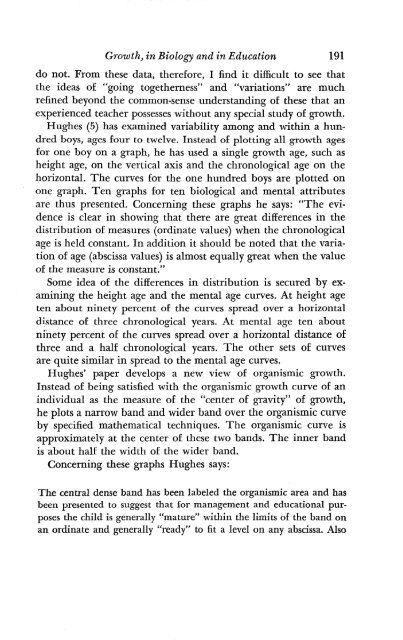Scientism and Values.pdf - Ludwig von Mises Institute
Scientism and Values.pdf - Ludwig von Mises Institute
Scientism and Values.pdf - Ludwig von Mises Institute
Create successful ePaper yourself
Turn your PDF publications into a flip-book with our unique Google optimized e-Paper software.
Growth) in Biology <strong>and</strong> in Education 191<br />
do not. From these data, therefore, I find it difficult to see that<br />
the ideas of "going togetherness" <strong>and</strong> "variations" are much<br />
refined beyond the common-sense underst<strong>and</strong>ing of these that an<br />
experienced teacher possesses without any special study of growth.<br />
Hughes (5) has examined variability among <strong>and</strong> within a hundred<br />
boys, ages four to twelve. Instead of plotting all growth ages<br />
for one boy on a graph, he has used a single growth age, such as<br />
height age, on the vertical axis <strong>and</strong> the chronological age on the<br />
horizontal. The curves for the one hundred boys are plotted on<br />
one graph. Ten graphs for ten biological <strong>and</strong> mental attributes<br />
are thus presented. Concerning these graphs he says: "The evidence<br />
is clear in showing that there are great differences in the<br />
distribution of measures (ordinate values) when the chronological<br />
age is held constant. In addition it should be noted that the variation<br />
of age (abscissa values) is almost equally great when the value<br />
of the measure is constant."<br />
Some idea of the differences in distribution is secured by examining<br />
the height age <strong>and</strong> the mental age curves. At height age<br />
ten about ninety percent of the curves spread over a horizontal<br />
distance of three chronological years. At mental age ten about<br />
ninety percent of the curves spread over a horizontal distance of<br />
three <strong>and</strong> a half chronological years. The other sets of curves<br />
are quite similar in spread to the mental age curves.<br />
Hughes' paper develops a new view of organismic growth.<br />
Instead of being satisfied with the organismic growth curve of an<br />
individual as the measure of the "center of gravity" of growth,<br />
he plots a narrow b<strong>and</strong> <strong>and</strong> wider b<strong>and</strong> over the organismic curve<br />
by specified mathematical techniques. The organismic curve is<br />
approximately at the center of these two b<strong>and</strong>s. The inner b<strong>and</strong><br />
is about half the width of the wider b<strong>and</strong>.<br />
Concerning these graphs Hughes says:<br />
The central dense b<strong>and</strong> has been labeled the organismic area <strong>and</strong> has<br />
been presented to suggest that for management <strong>and</strong> educational purposes<br />
the child is generally "mature" within the limits of the b<strong>and</strong> on<br />
an ordinate <strong>and</strong> generally "ready" to fit a level on any abscissa. Also
















